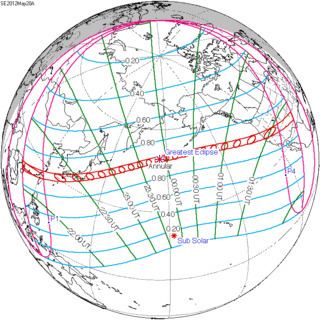Nature Annular Magnitude 0.9439 Max. width of band 237 km (147 mi) Date 20 May 2012 | Gamma 0.4828 Duration 346 sec (5 m 46 s) (P1) Partial begin 20:56:07 | |
 | ||
Other Instances Solar eclipse of April 8 - 2, Solar eclipse of July 2 - 20, Solar eclipse of August 2, Solar eclipse of March 9, Solar eclipse of March 20 | ||
Annular solar eclipse of may 20 2012
An annular solar eclipse took place on May 20, 2012 (May 21, 2012 in local time in the Eastern Hemisphere), with a magnitude of 0.9439. A solar eclipse occurs when the Moon passes between Earth and the Sun. Annular solar eclipse occurs when the Moon's apparent diameter is smaller than the Sun's, blocking most of the Sun's light and causing the Sun to look like an annulus (ring). An annular eclipse appears as a partial eclipse over a region of the Earth thousands of kilometres wide.
Contents
Visibility
It was the first annular eclipse in the continental U.S. since the solar eclipse of May 10, 1994 which was also the previous eclipse of this series Solar Saros 128.
It was predicted that the antumbra would pass over Hong Kong but due to weather it was not observable.
Solar eclipses 2011–2014
Each member in a semester series of solar eclipses repeats approximately every 177 days and 4 hours (a semester) at alternating nodes of the Moon's orbit. Note: Partial solar eclipses on January 4, 2011, and July 1, 2011, occur in the previous semester series.
Saros 128
It is a part of Saros cycle 128, repeating every 18 years, 11 days, containing 73 events. The series started with partial solar eclipse on August 29, 984 AD. It contains total eclipses from May 16, 1417 through June 18, 1471 and hybrid eclipses from June 28, 1489 through July 31, 1543. Then it progresses into annular eclipses from August 11, 1561 through July 25, 2120. The series ends at member 73 as a partial eclipse on November 1, 2282. The longest duration of totality was 1 minutes, 45 seconds on June 7, 1453.
